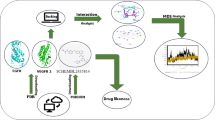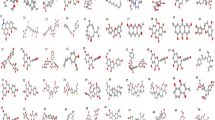Abstract
Aurora kinases belong to family of highly conserved serine/threonine protein kinases that are involved in diverse cell cycle events and play a major role in regulation of cell division. Abnormal expression of Aurora kinases may lead to cancer; hence, these are considered as a potential target in cancer treatment. In this research article, we identified three novel Aurora A inhibitors using modern computational tools. A four-point common 3D pharmacophore hypothesis of Aurora A (AurA) inhibitors was developed using a diverse set of 55 thienopyrimidine derivatives. A three-dimensional quantitative structure–activity relationship (3D-QSAR) study was carried out using atom-based alignment of diverse set of 55 molecules to evaluate the structure– activity relationships. Docking and 3D-QSAR studies were performed with the 3D structure of AurA to evaluate the generated pharmacophore. The pharmacophore model and 3D-QSAR results complemented the results of our docking study. The pharmacophore hypothesis, which yields the best results, was used to screen the Zinc ‘clean drug-like’ database. Various database filters such as 3D-arrangement of pharmacophoric features, predicted activity and binding interaction score were used to retrieve hits having potential AurA inhibition activity.








Similar content being viewed by others
References
Crane R, Gadea B, Littlepage L, Wu H, Ruderman JV (2004) Aurora A, Meiosis and Mitosis. Biol Cell 96:215–229. doi:10.1016/j.biolcel.2003.09.008
Pugacheva EN, Jablonski SA, Hartman TR, Henske EP, Golemis EA (2007) HEF1-Dependent Aurora A Activation Induces Disassembly of the Primary Cilium. Cell 129:1351–1363. doi:10.1016/j.cell.2007.04.035
Sardon T, Cottin T, Xu J, Giannis A, Vernos I (2009) Development and Biological Evaluation of a Novel Aurora A Kinase Inhibitor. ChemBioChem 10:464–478. doi:10.1002/cbic.200800600
Anand S, Penrhyn-Lowe S, Venkitaraman AR (2003) Aurora-A amplification overrides the mitotic spindle assembly checkpoint, inducing resistance to Taxol. Cancer Cell 3:51–62. doi:10.1016/S1535-6108(02)00235-0
McGrogan BT, Gilmartin B, Carney DN, McCann A (2008) Taxanes, microtubules and chemoresistant breast cancer. Biochim Biophys Acta 1785:96–132. doi:10.1016/j.bbcan.2007.10.004
Taylor S, Peters JM (2008) Polo and Aurora kinases: lessons derived from chemical biology. Curr Opin Cell Biol 20:77–84. doi:10.1016/j.ceb.2007.11.008
Hughes TV, Emmanuel SL, O’Grady HR, Connolly PJ (2008) 7-[1H-indol-2-yl]-2, 3-dihydro-isoindol-1-ones as dual Aurora-A/VEGF-R2 kinase inhibitors: Design, synthesis, and biological activity. Bioorg Med Chem Lett 18:5130–5133. doi:10.1016/j.bmcl.2008.07.090
Oslob JD, Romanowski MJ, Allen DA et al (2008) Discovery of potent and selective Aurora kinase inhibitor. Bioorg Med Chem Lett 18:4880–4884. doi:10.1016/j.bmcl.2008.07.073
Carter TA, Wodicka LM, Shah NP et al (2005) Inhibition of drug-resistant mutants of ABL, KIT, and EGF receptor kinases. Proc Natl Acad Sci USA 102:11011–11016. doi:10.1073/pnas.0504952102
Cheetham GM, Charlton PA, Golec JM, Pollard JR (2007) Structural basis for potent inhibition of the Aurora kinases and a T315I multi-drug resistant mutant form of Abl kinase by VX-680. Cancer Lett 251:323–329. doi:10.1016/j.canlet.2006.12.004
Pollard JR, Mortimore M (2009) Discovery and Development of Aurora Kinase Inhibitors as Anticancer Agents. J Med chem 52:2629–2651. doi:10.1021/jm8012129
Jakubczak JL (2010) PF-03814735, an orally bioavailable small molecule Aurora kinase inhibitor for cancer therapy. Mol Cancer Ther 9:883–94. doi:10.1158/1535-7163.MCT-09-0915
Langer T (2010) Pharmacophores in Drug Research. Mol Inf 29:470–475. doi:10.1002/minf.201000022
Srivastava V, Kumar A, Mishra B, Siddiqi M (2008) CoMFA and CoMSIA 3D-QSAR analysis of DMDP derivatives as anti-cancer agents. Bioinformation 2:384–391
Zhong M, Bui M, Shen W et al (2009) Aminobenzimidazoles as potent Aurora kinase inhibitors. Bioorg Med Chem Lett 19:5158–5161. doi:10.1016/j.bmcl.2009.07.016
McClellan WJ, Dai Y, Abad-Zapatero C et al (2011) Discovery of potent and selective thienopyrimidine inhibitors of Aurora kinases. Bioorg Med Chem Lett 21:5620–5624. doi:10.1016/j.bmcl.2011.06.041
Phase 2.5 (2009) Schrödinger. LLC, New York
Dixon SL, Smondyrev AM, Knoll EH, Rao SN, Shaw DE, Friesner RA (2006) PHASE: a new engine for pharmacophore perception, 3D-QSAR model development, and 3D database screening: 1. Methodology and preliminary results. J Comput Aided Mol Des 20:647–671. doi:10.1007/s10822-006-9087-6
Dixon SL, Smondyrev AM, Rao SN (2006) PHASE: A Novel Approach to Pharmacophore Modeling and 3D Database Searching. Chem Biol Drug Des 67:370–372. doi:10.1111/j.1747-0285.2006.00384.x
Kolossvary I, Guida WC (1996) Low mode search: an efficient, automated computational method for conformational analysisapplication to cyclic and acyclic alkanes and cyclic peptides. J Am Chem Soc 118:5011–5019. doi:10.1021/ja952478m
Glide, version 5.5 (2009) Schrödinger. LLC, New York
Lipinski (2000) J Pharmacol Toxicol Meth 44:235–249. doi:10.1016/S1056-8719(00)00107-6
OSIRIS (2001) Thomas Sander, Actelion Pharmaceuticals Ltd.
Acknowledgments
This work was supported by the Council of Scientific and Industrial Research- Unit for Research and Development of Information Products. S.R.C thanks the Centre for Development of Advanced Computing (CDAC) Bioinformatics Resource and Application Facility, Pune for computational facility.
Author information
Authors and Affiliations
Corresponding author
Rights and permissions
About this article
Cite this article
Chavan, S.R., Dash, R.C., Alam, M.S. et al. Identification of new novel scaffold for Aurora A inhibition by pharmacophore modeling and virtual screening. Mol Divers 18, 853–863 (2014). https://doi.org/10.1007/s11030-014-9535-5
Received:
Accepted:
Published:
Issue Date:
DOI: https://doi.org/10.1007/s11030-014-9535-5




